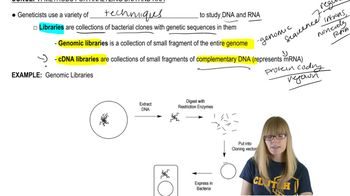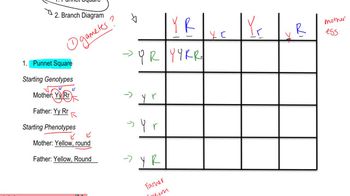Table of contents
- 1. Introduction to Genetics51m
- 2. Mendel's Laws of Inheritance3h 37m
- 3. Extensions to Mendelian Inheritance2h 41m
- 4. Genetic Mapping and Linkage2h 28m
- 5. Genetics of Bacteria and Viruses1h 21m
- 6. Chromosomal Variation1h 48m
- 7. DNA and Chromosome Structure56m
- 8. DNA Replication1h 10m
- 9. Mitosis and Meiosis1h 34m
- 10. Transcription1h 0m
- 11. Translation58m
- 12. Gene Regulation in Prokaryotes1h 19m
- 13. Gene Regulation in Eukaryotes44m
- 14. Genetic Control of Development44m
- 15. Genomes and Genomics1h 50m
- 16. Transposable Elements47m
- 17. Mutation, Repair, and Recombination1h 6m
- 18. Molecular Genetic Tools19m
- 19. Cancer Genetics29m
- 20. Quantitative Genetics1h 26m
- 21. Population Genetics50m
- 22. Evolutionary Genetics29m
2. Mendel's Laws of Inheritance
Dihybrid Cross
Problem 26
Textbook Question
Another recessive mutation in Drosophila, ebony (e), is on an autosome (chromosome 3) and causes darkening of the body compared with wild-type flies. What phenotypic F₁ and F₂ male and female ratios will result if a scalloped-winged female with normal body color is crossed with a normal-winged ebony male? Work out this problem by both the Punnett square method and the forked-line method.
 Verified step by step guidance
Verified step by step guidance1
Identify the genotypes of the parents: The scalloped-winged female with normal body color is homozygous recessive for the scalloped wings (ss) and homozygous dominant for normal body color (EE). The normal-winged ebony male is homozygous dominant for normal wings (SS) and homozygous recessive for ebony body color (ee).
Determine the gametes produced by each parent: The female can produce gametes with genotypes (sE), and the male can produce gametes with genotypes (Se).
Use the Punnett square method: Set up a Punnett square with the female gametes on one side and the male gametes on the other. Fill in the squares to determine the genotypes of the F₁ generation.
Analyze the F₁ generation: All F₁ offspring will have the genotype (SsEe), which means they will have normal wings and normal body color, as both traits are dominant.
Use the forked-line method for the F₂ generation: Cross the F₁ individuals (SsEe x SsEe) and use the forked-line method to determine the phenotypic ratios for each trait separately, then combine the results to find the overall phenotypic ratios for the F₂ generation.
Recommended similar problem, with video answer:
 Verified Solution
Verified SolutionThis video solution was recommended by our tutors as helpful for the problem above
Video duration:
2mPlay a video:
Was this helpful?
Key Concepts
Here are the essential concepts you must grasp in order to answer the question correctly.
Autosomal Inheritance
Autosomal inheritance refers to the transmission of genetic traits located on the autosomes, which are the non-sex chromosomes. In this case, the ebony mutation in Drosophila is located on chromosome 3, an autosome. Understanding how traits are inherited through these chromosomes is crucial for predicting phenotypic ratios in offspring.
Recommended video:
Guided course

Autosomal Pedigrees
Punnett Square
The Punnett square is a diagram used to predict the genotypic and phenotypic outcomes of a genetic cross. By organizing the alleles of the parents, it allows for a visual representation of how traits may combine in the offspring. This method is particularly useful for determining the ratios of different phenotypes resulting from a cross.
Recommended video:
Guided course

Chi Square Analysis
Forked-Line Method
The forked-line method is a systematic approach to calculate the probabilities of different genotypes and phenotypes in offspring from multiple traits. It involves breaking down the inheritance of each trait into separate branches, allowing for a comprehensive view of how traits assort independently. This method is especially helpful when dealing with dihybrid or more complex crosses.
Recommended video:
Guided course

Methods for Analyzing DNA and RNA
Related Videos
Related Practice





